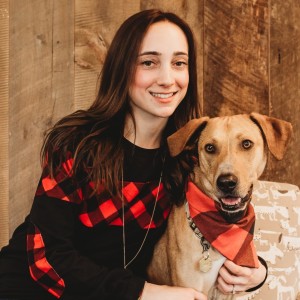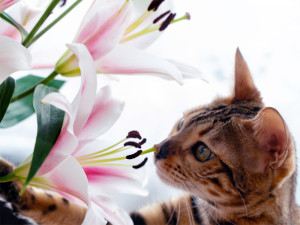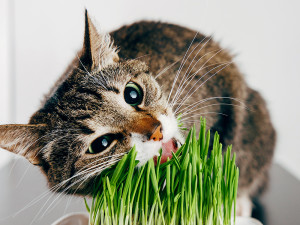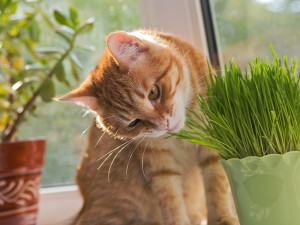Are Hydrangeas Toxic to Cats?
They make your lawn look picture-perfect, but keep your cat away. Here’s why.

Share Article
Have you seen any hydrangeas while you were out and about today? If it is summer, you are bound to see them as you drive through your local neighborhood. Hydrangeas are large shrubs that grow well in many climates, and are known for their flowers that grow in the shape of a snowball. These flowers can range from blues and purples to pinks and whites, and bloom from summer to fall.
Are hydrangeas toxic to my cat?
Hydrangeas are a popular shrub in the suburbs, but if you have a cat, you may want to think twice about bringing their beautiful flower indoors for display. All parts of the hydrangea are toxic to cats, with the flower being extremely toxic.
“Yes, hydrangeas are toxic to cats, with all parts of the plant, especially the leaves and flowers, being toxic,” veterinarian Dr. Preston Turano says. “The plant contains cyanogenic glycoside, which can cause cyanide intoxication, but that is usually rare. Most cats will experience gastrointestinal issues such as vomiting, salivating, and diarrhea.”
Why are hydrangeas dangerous to cats?
Hydrangeas are poisonous because they contain amydalin, a toxin that comes out when the plant is chewed on. When the plant is chewed, the toxin moves into the bloodstream and can cause cyanide poisoning, which is extremely fast-acting. When this toxin hits the bloodstream, it prevents the body from using oxygen properly.

Unfortunately, there is no safe amount of this plant that your cat should eat. “Cats should not eat any part of the plant, and if you suspect they have ingested it, then your cat should be seen by a veterinarian,” Dr. Turano says.
What should I do if my cat has eaten hydrangeas?
If your cat has eaten the hydrangea, you should call your vet and then watch for symptoms of concern, like vomiting, diarrhea, and lethargy.
Diagnosing plant poisoning in cats
If you think your cat ate any of the hydrangea plant, call your vet. If they throw up or have diarrhea, it could mean something else is going on, so it’s important for your vet to have this context.
Symptoms of plant poisoning in cats
Symptoms of hydrangea poisoning in cats include but are not limited to:
Nausea
Vomiting
Diarrhea (may contain blood)
Abdominal pain
Treatment
Treatment for hydrangea poisoning in cats depends on how much of the plant they ate and their symptoms. They may recommend fluid therapy and medications for vomiting and diarrhea. If symptoms seem severe, your vet may recommend bloodwork or other diagnostics. They may require hospitalization in these cases.
How do I stop my cat from eating hydrangeas?
The best way to prevent your cat from eating hydrangeas is by keeping them out of your home. This will be the safest way to assure that your cat will not ingest them. If you do have to bring the hydrangea plant into your home, then be sure to put the plant out of reach of your cat.
The bottom line: Is (insert plant name) poisonous for my (dog or cat)?
Boilerplate response that urges pet parents to be careful in monitoring what their pet consumes.
Other plants that are safe for dogs
Orchids (Orchidaceae): These flowers are perfectly OK to have around the house.
Roses (Rosa rubiginosa): are another safe option for your kitty.
Spider plant (Chlorophytum comosum): Spider plants are great for cleaning the airopens in new tab in homes. They’re also safe for cats and easy to care for.
Other plants that are dangerous for dogs
Rattlesnake plantopens in new tab (Goeppertia insignis): This tropical plant is cat-safe and provides the same jungle aesthetic as the snake plant, without harming your kitty.
Blushing bromeliad (Neoregelia carolinae): These plants are great if you want some color in your home without having to worry that your cat will be safe if they interact with it.
African violet (Saintpaulia ionantha): African violets also provide vibrant color and don’t pose a danger to your cat.
FAQs (People also ask):
How much of the hydrangea plant can a cat eat?
Your cat cannot safely eat any amount of the hydrangea plant.
Are (insert plant name) poisonous to (dogs or cats) if they smell them?
Why do cats like hydrangeas?
Cats are known for their curiosity. Some cats may like to taste a new plant that has come into their home.
Can cats eat hydrangeas?
Cats should not ingest any part of the hydrangea plant.
References:

Danielle Vrabel, CPDT-KA
Danielle Vrabel is a dog trainer who earned her CPDT-KA in 2020. Danielle is a proud pet mom of five pets: two dogs, two cats, and a corn snake. Danielle has fostered over ten dogs and fifteen cats and kittens, as well as helped train shelter dogs before they are adopted. Both of Danielle’s dogs are pet therapy dogs, where she also volunteers her time helping evaluate future therapy dogs.
Related articles
![Cute Bengal cat sniffs lilly flowers.]()
Are Lilies Toxic to Cats?
This holiday weekend, keep those Easter lilies far away from your kitty.
![A brown cat with a snake plant.]()
Are Snake Plants Toxic to Cats?
All you need to know about snake plants — plus, other plants that are toxic (and safe).
![Cat chewing on cat grass]()
The 10 Best Non-Toxic House Plants for Cats
Cats love the crunch of a houseplant. These will do them no harm.
Are Petunias Toxic to Cats?
If your kitty is poking exploring your garden, this flower isn’t much of a danger. Here’s why.
Are Daisies Toxic to My Cat?
They’re cute in the garden, not so much for your cat. Here’s why.
![Cat sitting on a window sill eating cat grass]()
Sweet Greens: The Best Cat Grass Grow Kits
Not to be confused with catnip (or other buds).








